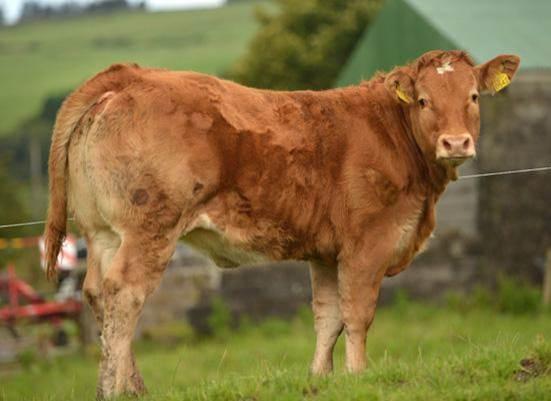Calving at two years of age- a farmers experience

By Charlie Devaney,
Beef Advisor,
Teagasc Castlerea.
Shane Keavney farms full-time, with help from his wife Grainne and three children in Granlahan, Ballinlough, Co. Roscommon. He took over the farm in 2014, starting with five Saler in-calf heifers and has since grown the suckler cow herd to 37.
The spring-calving suckler production system operated is uncomplicated. The cow type is mainly Limousin x Saler, and a ‘terminal’ Charolais bull is used on the mature cows. All cows are calved in February and March. The male calves are finished as under-16 month bull beef. The heifers are sold as ‘forward’ stores or slaughtered at under-21 months of age.
All replacement breeding heifers are sourced from within the herd and are calved at two years of age. At this point, all of the cows in the herd have calved at two years of age and have an average mature weight of 650 kg. Shane picks the best heifers for potential replacements from the best cows early in the year. At least 20% of the female calves in the herd are identified as potential breeding replacements. These heifers are the progeny of cows with the following specific characteristics;
- 365-day calving interval or less
- Calve early in the season
- Good docility
- Consistently delivers a top-quality calf
- High maternal Replacement Index: €100+
- Has good conformation, milking ability and feet
This group of heifers are ‘priority’ stock on the farm. The heifer must have a weaning weight of 280 kg or greater. During the ‘first’ winter, they receive high quality (>70% dry matter digestibility – DMD) grass silage ad libitum plus 1.0 kg of concentrate per head daily. The target live weight gain is 0.6 kg/day over the first winter.
The maiden heifers are let out to grass in spring as early as possible, and will be at least 410 kg at the time of breeding on 1 May. Artificial insemination is used on the heifers as a stock bull cannot be justified for a group of this size. A vasectomised bull with a chin ball is used for heat detection.
This year, 12 heifers were identified for breeding and ten went in-calf to AI. Six are in-calf to a sexed semen Limousin bull called ‘Tweedale Lennox’, while the other four are in-calf to Limousin using conventional semen. Utilising sexed semen guarantees heifers from AI. The bull ‘Lennox’ is easy-calving (2.37%) and has a high Replacement Index of €157.
During the second grazing season, the in-calf heifers are offered top-quality leafy grass. During the second winter they are penned on their own, and are offered grass silage ad- libitum. Shane keeps a close eye on body condition, to ensure that the heifers are ‘fit and not fat’ prior to calving. The heifers calve along with the main cow herd and after calving receive high-digestibility (>70% DMD), first-cut grass silage. In spring, weather permitting, Shane tries to get these heifers out to grass first. The post-calving ‘care’ is very important to ensure that they will go back in-calf again at the start of their third grazing season.
This article was prepared for the National Beef Conference 2022, by Gabriel Trayers and Charlie Devaney. Shane Keavney, is a participant of the Teagasc FutureBeef Program. Teagasc provides a Local Advisory and Education service to farmers. They have offices based in Roscommon Town (Tel: 090 6626166), Castlerea (Tel: 094 9620160) and Longford Town (Tel: 043 3341021), You can find us on Facebook @Teagascroscommonlongford, twitter @teagascRNLD and YouTube. And follow the hash-tag #RNLDwebinars for information about local farm webinars. Email; RoscommonLongfordAdvisory@teagasc.ie
